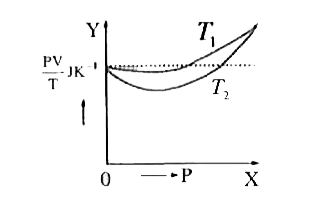(A): Mean free path of gas molecules, varies inversely as density of the gas.
(R): Mean free path of gas molecules is defined as the average distance travelled by a molecule between two successive collisions. Solution in Telugu
If both (A) and (R) are true and (R) is the correct explanation of (A)
If both (A) and (R) are true and (R) is not the correct explanation of (A)
(A) is true but (R) is false
(A) is false and (R) is true
The correct Answer is:A
Step by step video, text & image solution for (A): Mean free path of gas molecules, varies inversely as density of the gas. (R): Mean free path of gas molecules is defined as the average distance travelled by a molecule between two successive collisions. by Physics experts to help you in doubts & scoring excellent marks in Class 11 exams.
Topper's Solved these Questions
- BOOK - AAKASH SERIESCHAPTER - KINETIC THEORY OF GASESEXERCISE - Exercise -II32videos
KINETIC THEORY OF GASES
- BOOK - AAKASH SERIESCHAPTER - KINETIC THEORY OF GASESEXERCISE - Practice Exercise15videos
KINETIC THEORY OF GASES
- BOOK - AAKASH SERIESCHAPTER - KINETIC THEORY OF GASESEXERCISE - Problems12videos
KINETIC THEORY OF GASES
- BOOK - AAKASH SERIESCHAPTER - KINEMATICSEXERCISE - ADDITIONAL PRACTICE EXERCISE (PRACTICE SHEET (ADVANCED)) (Integer Type Questions)12videos
KINEMATICS
- BOOK - AAKASH SERIESCHAPTER - LAWS OF MOTIONEXERCISE - PRACTICE EXERCISE108videos
LAWS OF MOTION
Similar Questions
cylinder of capacity 20 litres is filled with H2 gas. The total average kinetic energy of translatory motion of its molecules is 1.5×105 J. The pressure of hydrogen in the cylinder is
02:58View SolutionThe kinetic energy of translation of 20gm of oxygen at 47∘C is (molecular wt. of oxygen is 32gm/mol and R=8.3 J/mol/K)
03:08View SolutionFigure shows plot of PVT and P for 2gm of oxygen gas at two different temperatures

(i) The significance of dotted line
(ii) The relation between T1andT2
(iii) The value of PVT where the curves meet on the x-axis.01:40View SolutionThree particles start from origin at the same time: one with velocity v1 along positive x - axis, the second along the positive y-axis with a velocity v2 and the third along the line y=x with such a speed that all the three always stay in a straight line, then the velocity of the third particle is √kV1V2(V1+V2).
03:30View SolutionA force of 50 N acts on a body of mass 10 kg at rest. Its velocity after 5 seconds if the same force acts, is
03:14View SolutionAssertion : Mean free path of a gas molecule varies inversely as density of the gas. Reason : Mean free path varies inversely as pressure of the gas.
03:14View SolutionMean free path of a gas molecule is
04:01View Solutionयदि किसी गैसय के अणुओं की त्रिज्या r हो तो उनका माध्य-मुक्त पथ व्युत्क्रमानुपाती होता है:
03:15View Solutionअणु की दो क्रमिक टक्करों के माध्य दूरी मुक्त पथ λ कहलाती है । यह निर्भर करती है |
गैस के अणु के द्रव्यमान m पर (λ∝m),07:27View SolutionMean free path of a gas molecule is :
07:39View SolutionMean free path of a gas molecule is :
01:08View SolutionStatement I: Mean free path of gas molecules,varies inversely with density of the gas Statement II: Mean free path of gas molecule is defined as the average distance travelled by a molecule between two successive collisions.
01:08View SolutionStatement I : Mean free path of a gas molecule varies inversely as the density of gas.
Statement II : Mean free path of gas molecule is defined as the average distance travelled by a molecule between two successive collisions.02:14View Solutionगैस अणुओं का माध्य मुक्त पथ है
03:12View Solutionप्रक्कथन : गैस अणुओं का औसत मुक्त पथ, उसके घनत्व के व्युत्क्रम के अनुसार परिवर्तित होता है।
कारण : माध्य मुक्त पथ, गैस के दाब के व्युत्क्रम के अनुसार परिवर्तित होता है।01:34View SolutionThe mean free path of a gas molecule is the distance
View Solution

